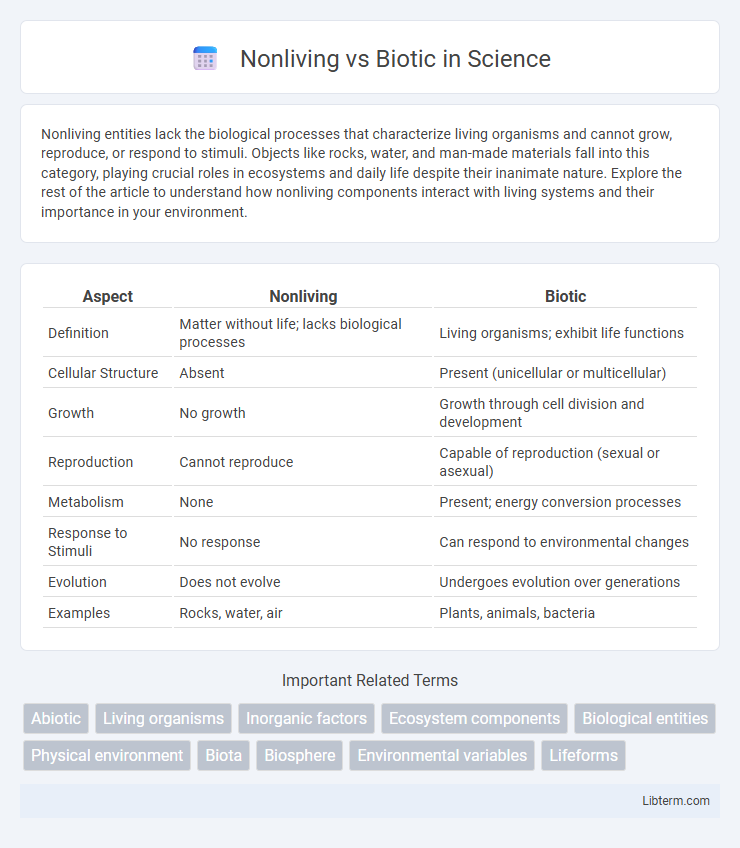Nonliving entities lack the biological processes that characterize living organisms and cannot grow, reproduce, or respond to stimuli. Objects like rocks, water, and man-made materials fall into this category, playing crucial roles in ecosystems and daily life despite their inanimate nature. Explore the rest of the article to understand how nonliving components interact with living systems and their importance in your environment.
Table of Comparison
| Aspect | Nonliving | Biotic |
|---|---|---|
| Definition | Matter without life; lacks biological processes | Living organisms; exhibit life functions |
| Cellular Structure | Absent | Present (unicellular or multicellular) |
| Growth | No growth | Growth through cell division and development |
| Reproduction | Cannot reproduce | Capable of reproduction (sexual or asexual) |
| Metabolism | None | Present; energy conversion processes |
| Response to Stimuli | No response | Can respond to environmental changes |
| Evolution | Does not evolve | Undergoes evolution over generations |
| Examples | Rocks, water, air | Plants, animals, bacteria |
Understanding Nonliving and Biotic Components
Nonliving components refer to abiotic factors such as water, sunlight, soil, and temperature that influence ecosystems without possessing life. Biotic components encompass living organisms, including plants, animals, bacteria, and fungi, which interact with each other and their environment to form complex biological networks. Understanding the interplay between nonliving and biotic components is crucial for studying ecosystem dynamics, biodiversity, and environmental balance.
Defining Nonliving (Abiotic) Factors
Nonliving or abiotic factors refer to the physical and chemical components of an ecosystem that lack life, such as sunlight, temperature, water, minerals, and atmospheric gases. These factors influence the survival, growth, and reproduction of biotic (living) organisms by shaping their habitat and available resources. Abiotic elements play a crucial role in ecological processes like nutrient cycling, energy flow, and habitat formation, directly impacting biodiversity and ecosystem stability.
What Are Biotic Components?
Biotic components refer to all living organisms within an ecosystem, including plants, animals, fungi, bacteria, and microorganisms that interact and depend on each other for survival. These living entities contribute to essential ecological processes such as nutrient cycling, energy flow, and reproduction, shaping the structure and dynamics of the environment. Unlike nonliving components like water, minerals, and climate, biotic factors actively influence ecosystem health and biodiversity.
Key Differences Between Nonliving and Biotic
Nonliving entities lack cellular structure, metabolism, and the ability to reproduce, whereas biotic components are characterized by living cells, growth, and reproduction. Nonliving matter includes rocks, water, and minerals, which do not respond to stimuli, unlike biotic organisms that exhibit responsiveness and adaptation to their environment. The key differences lie in biological processes and life-sustaining functions, making biotic elements integral to ecosystems, while nonliving elements form the physical environment.
Examples of Nonliving Factors in Ecosystems
Nonliving factors in ecosystems, also known as abiotic components, include sunlight, temperature, water, soil, and atmospheric gases. These elements influence the survival and distribution of living organisms by regulating habitat conditions and nutrient availability. Examples of nonliving factors are mineral content in soil, pH levels of water bodies, and climatic variables such as humidity and wind patterns.
Examples of Biotic Factors in Ecosystems
Biotic factors in ecosystems include all living organisms such as plants, animals, fungi, bacteria, and protists that interact and influence each other's survival and reproduction. Examples include trees providing habitat for birds, predators like wolves controlling prey populations, and decomposers like fungi breaking down organic matter to recycle nutrients. These living components shape ecosystem dynamics and directly affect the flow of energy and matter within the environment.
The Role of Nonliving Components in Nature
Nonliving components, such as water, sunlight, minerals, and temperature, play a crucial role in regulating ecosystems by shaping the environment in which biotic organisms live. These abiotic factors influence growth, reproduction, and survival rates of plants, animals, and microorganisms, directly affecting biodiversity and ecosystem stability. Understanding the interaction between nonliving elements and biotic communities is essential for ecosystem management and conservation efforts.
The Importance of Biotic Components
Biotic components, such as plants, animals, fungi, and microorganisms, play a crucial role in maintaining ecosystem balance by driving nutrient cycling, energy flow, and habitat formation. These living organisms interact dynamically, supporting biodiversity and enabling ecosystem resilience against environmental changes. Nonliving factors like climate and soil provide the necessary context, but the presence of biotic components is essential for sustaining life and ecological processes.
Interactions Between Nonliving and Biotic Elements
Nonliving elements such as sunlight, water, and minerals directly influence biotic components by providing essential resources for growth, metabolism, and survival in ecosystems. Biotic entities, including plants, animals, and microbes, interact dynamically with abiotic factors through processes like photosynthesis, respiration, and nutrient cycling. These interactions shape habitat conditions and ecological balance, driving evolutionary adaptations and biodiversity.
Nonliving vs Biotic: Impact on Ecosystem Balance
Nonliving factors such as sunlight, temperature, and water availability directly influence the growth and survival of biotic components like plants, animals, and microorganisms, thereby shaping ecosystem dynamics. The interaction between abiotic elements and biotic populations maintains ecosystem balance by regulating nutrient cycles, energy flow, and habitat conditions. Disruptions to nonliving factors can lead to significant changes in species distribution and ecosystem functionality, highlighting their critical role in sustaining ecological stability.
Nonliving Infographic

 libterm.com
libterm.com